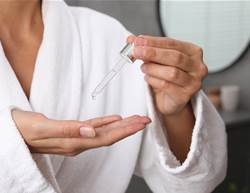Weak nails are a total buzzkill. But as tempting as it is to hide your thin and peeling nails under a permanent gel manicure, there are plenty of lifestyle tweaks that, collectively, can bring your nails back to their former glory.
So, what causes our nails to weaken in the first place?
“Our nails are made up of layers of keratin, a protein that’s also found in our hair and skin,” says dermatologist Dr Rhonda Klein. “As we age, the cells in our bodies produce keratin at a slower rate, which can cause the nails to weaken and appear dry and dull.”
It’s not just the ageing process that can do a number on our nails, though, she adds. Exposure to elements (think: extreme cold, excessive hand-washing, contact with chemicals) can all deplete the nails, leaving them dry and vulnerable.
Fortunately, that also means much of what it takes to strengthen your nails is (literally) in your hands - and here’s exactly how to make it happen, according to doctors:
1. Moisturise your hands and nails regularly
Frequently moisturising your nails and the surrounding skin with a hand cream can prevent further impairment of the integrity of the nails, says dermatologist Dr Rina Allawh. Ointments, such as Vaniply Skin Protectant, pull a double-duty by nourishing your nails and protecting them from future damage by locking in moisture.
Cuticle oil helps to repair, nourish, and moisturise weak nails as well, says dermatologist Dr Sheel Desai Solomon. “I recommend L’Occitane Shea Nourishing Nail & Cuticle Oil,” she says. “It’s formulated with a high concentration of shea oil (30%) to help soften cuticles and nourish nails.”
2. Keep them on the shorter side
“If you’re having trouble with weak nails, consider cutting down the length while you build up their strength,” suggests Dr Solomon. “Shorter nails are less prone to breaking because there are fewer exposed edges to tear, and less surface area where water and chemicals can be absorbed.” Once trimmed, prevent snags by gently rounding the edges with a nail file.
3. Become a nail-filing master
Go with a soft nail file to keep the edges of your nails smooth, says Dr Klein. With rougher grains, you run the risk of making tears in the nail, which can lead to peeling and hangnails.
File your nails in one direction, using long and swift (but gentle) strokes. “Back and forth see-saw motions will cause the nail to splinter,” says Dr Solomon.
4. Ditch nail polish removers that contain acetone
A nail polish remover loaded with acetone (the solvent responsible for dissolving nail polish lightning-fast) is harsh on weak nails and can dry them out something fierce. “This can cause peeling, splitting, and those unsightly white, mottled marks,” says Dr Solomon.
5. Don’t overdo the hand sanitiser
Because hand sanitisers are typically alcohol-based, constantly applying the stuff can dry out your nails and leave them super brittle. “If you have to use hand sanitiser, try not to get it on your nails, and don’t overdo it,” says Dr Solomon.
Using hand sanitiser wipes can make it easier to avoid the nail area during application. If you prefer the liquid variety, make sure to slather on moisturiser afterward to balance the scales.
6. Eat more foods that promote strong nails
Avoid yo-yo dieting, which can lead to vitamin deficiencies that may put the strength of your nails in jeopardy. Make sure you eat enough protein and calcium too, which are thought to promote nail health, says dermatologist Dr Robin Evans. Loading up on biotin-rich foods, such as veggies, eggs, and nuts, may also help.
7. Stay hydrated
“Drinking enough water is essential for health, and nail health is no exception,” says Dr Solomon. “Without adequate moisture, nails can become brittle and break or peel easily.” Staying hydrated will help your nails retain moisture and stay strong. (Here’s a handy hydration calculator to make sure you’re getting enough.)
8. Minimise water exposure
When your hands are soaked in water for long periods of time (say, while doing the dishes, taking a bath, or going for a swim), this doesn’t just dehydrate your skin - it sucks the moisture out of your nails, too.
“Water follows water, so the water in our bodies depletes the longer we soak in it,” says Dr Klein. Things like wearing cotton-lined gloves during chores and keeping your nails outside the water for most of your soak or swim can minimise the blowback - and if that’s not possible, thoroughly moisturising your hands and nails post-dunk is the next best thing.
9. Add a nail strengthener to your routine
Prescription topical agents can help to strengthen weakened nails. While OTC nail hardeners can do the trick in the short-term, prescription strengtheners are the best choice for long-term use, since they contain chemicals that both increase the strength of the nail and trap moisture in to prevent future brittleness.
“Consistent and dedicated use of the nail hardeners is key for successful results,” says Dr Allawh.
10. Cut back on gel and acrylic manicures
They may be touted as an easy alternative for people who have trouble growing their nails, but frequent gel or acrylic manicures can cause your nails to peel, weakening them in the process. These manicures also expose your digits to excessive amounts of acetone in the soak required to remove them, which is very drying to the nail, says Dr Klein. If you prefer to keep these types of manicures on rotation, make sure to either give your nails time to breathe between applications or save them for special occasions.
11. Always apply base and top coats
Base and top coats are especially helpful when your nails are on the weaker side because they provide your nails with an additional protective barrier from things like dehydration and breakage, says Dr Evans. Essie’s Grow Stronger Base Coat leaves nails nourished and protected, for example, while the brand’s Good to Go Top Coat protects your mani from chipping and peeling.
12. Take breathers between manicures
Bottom line: Your nails need to breathe. “Constant use of polish, even non-toxic polish, can weaken the nail,” says Dr Solomon. If you find that your nails have become especially fragile (and they’re painted more often than not), give them a month off from nail polish to allow them to grow and strengthen. Applying a keratin treatment between manicures, such as CND RescueRXx, can help nourish your nails during the hiatus.
13. Get a check-up
While weak nails are usually due to exposure to elements and the ageing process, check in with your doctor if it’s a new problem and isn’t responding to at-home remedies.
“There are specific conditions, such as an iron deficiency (anaemia), hypothyroidism, psoriasis and Raynaud’s Syndrome (a circulatory condition) that can affect nail strength,” says Dr Klein. The sooner you treat any underlying health issues that might be messing with your nails, the sooner they can grow in healthier and stronger.










